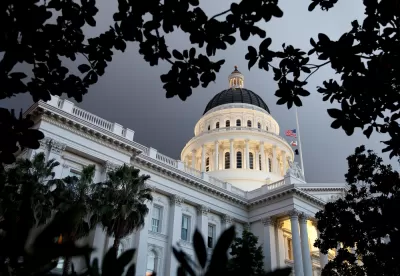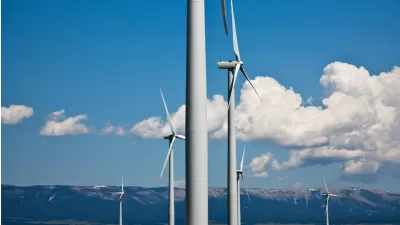It has been a good year for environmentalists, but it hasn't come easily, as seen in the much-celebrated but delayed passage of SB 32 that continues the landmark emissions reductions first set in 2006. Joe Mathews explains the transitions underway.

The passage of two key environmental bills 'joined at the hip,' SB 32 and AB 197, is the basis of an insightful column — not on the bills but their authors, Sen. Fran Pavley (D-Agoura Hills, Los Angeles County) and first-term Assemblyman Eduardo Garcia (D-Coachella, Riverside County), respectively, by Joe Mathews, who writes the Connecting California column for Zócalo Public Square.
The termed-out Pavley authored landmark environmental bills AB 32, The Global Warming Solutions Act of 2006 and AB 1493, Vehicular emissions: greenhouse gases, signed into law by Gov. Gray Davis in 2002, more often simply called the Pavley (or Clean Car) Standards.
According to Assembly Speaker Anthony Rendon (D-Paramount, Los Angeles County), the Pavley-Garcia partnership came "together at the Paris climate talks in December, when Garcia was added to a California delegation that included Gov. Jerry Brown, legislative leaders, and Pavley."
Mathews doesn't go into the relationship of the two bills that passed the legislature last week (more on that below) other than stating, "SB 32 extends the greenhouse gas reduction targets to 2030, and AB 197 creates oversight of state climate programs to make sure their benefits help the economies and public health of poorer and more polluted communities." Instead, his piece is about the changes in environmental leadership underway illustrated by the two authors.
The change goes far beyond generational. Most evident is a policy "shift in focus, from greenhouse gases to the impact of climate change—and measures to combat it—on people and specific places," and a geographic shift as growth has moved inland, away from the high housing costs of coastal cities.
Along with the generational change of leadership comes one with more diversity, represented by Garcia and Senate President pro Tem Kevin de León, reflecting the fast-growing Latino population, 38 percent of the state's population in 2010.
De León is author of another landmark bill, SB 350 passed last year that increases the renewable portfolio standard to generating 50 percent of electricity from renewable sources by 2030 and doubling energy efficiency standards in buildings by the same year.
But reductions are no longer sufficient, as illustrated by another de Léon key bill, SB 535 in 2012 that requires that 25 percent of cap-and-trade auction proceeds be direct to projects that provide benefits to disadvantaged communities
There are more constituents for climate change legislation, and thus higher expectations. And that has forced climate legislation to do more than mandate reductions in greenhouse gases; representatives of the state’s poorer, inland places are demanding that regulations and programs improve public health and create job opportunities in their communities.
The rather uneasy relationship between SB 32 and AB 197 is the topic of a San Diego Union-Tribune editorial which asks, "Is this it for California’s big climate change laws?" It explains why Garcia's bill was needed for Pavley's to pass.
His bill is meant to address the concerns of 20 or so moderate Assembly Democrats, some from poorer communities, who have begun to question the idea that green regulations benefit their home district.
But any Californian who values the state’s reputation as an environmental pioneer needs to worry about the fault lines among state Democrats exposed by the debate over AB 197 and by the failure in 2015 of Brown’s and Senate President Kevin de León’s push for a new law dramatically reducing gasoline use in the state.
Liam Dillon reported for the Los Angeles Times on the growing divisions in the Democratic party, particularly in the Assembly where many Senate climate bill die due to dissent from a number of black and Latino leaders. He includes the debate about how much of the unallocated $1.4 billion of Greenhouse Gas Reduction Funds should be directed to "disadvantaged communities — defined as regions with high levels of pollution and high poverty." A compromise was reached on Aug. 31, the last day of the 2016 legislative session.
Capital Public Radio has a roundup of action on the final day.
FULL STORY: The Next Big Shift in California’s Climate Change Movement

Planetizen Federal Action Tracker
A weekly monitor of how Trump’s orders and actions are impacting planners and planning in America.

San Francisco's School District Spent $105M To Build Affordable Housing for Teachers — And That's Just the Beginning
SFUSD joins a growing list of school districts using their land holdings to address housing affordability challenges faced by their own employees.

The Tiny, Adorable $7,000 Car Turning Japan Onto EVs
The single seat Mibot charges from a regular plug as quickly as an iPad, and is about half the price of an average EV.

As Trump Phases Out FEMA, Is It Time to Flee the Floodplains?
With less federal funding available for disaster relief efforts, the need to relocate at-risk communities is more urgent than ever.

With Protected Lanes, 460% More People Commute by Bike
For those needing more ammo, more data proving what we already knew is here.

In More Metros Than You’d Think, Suburbs are Now More Expensive Than the City
If you're moving to the burbs to save on square footage, data shows you should think again.
Urban Design for Planners 1: Software Tools
This six-course series explores essential urban design concepts using open source software and equips planners with the tools they need to participate fully in the urban design process.
Planning for Universal Design
Learn the tools for implementing Universal Design in planning regulations.
Smith Gee Studio
City of Charlotte
City of Camden Redevelopment Agency
City of Astoria
Transportation Research & Education Center (TREC) at Portland State University
US High Speed Rail Association
City of Camden Redevelopment Agency
Municipality of Princeton (NJ)





























